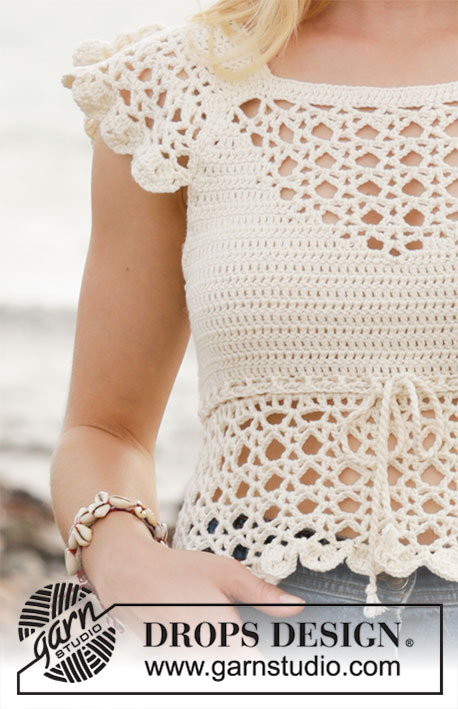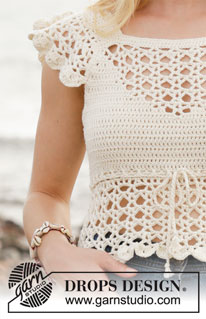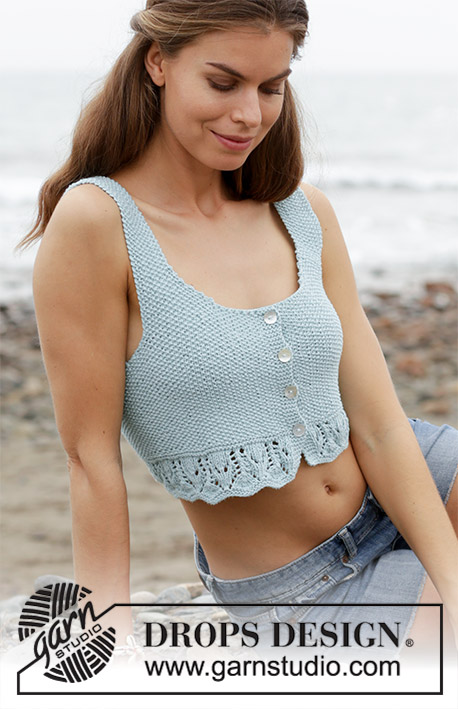California Dream |
|||||||||||||||||||||||||||||||||||||||||||
 |
 |
||||||||||||||||||||||||||||||||||||||||||
Crocheted top with lace pattern and flounce. Size: S - XXXL Piece is crocheted in DROPS Cotton Merino.
DROPS 190-21 |
|||||||||||||||||||||||||||||||||||||||||||
|
INFORMATION FOR PATTERN: PATTERN: See diagrams A.1 to A.5. INCREASE TIP-1: Increase 1 double crochet by working 2 double crochets in same stitch. CROCHET TIP-1 (applies to body but not diagram): Replace first double crochet at beginning of every row with 3 chain stitches. CROCHET TIP-2 (applies to body but not diagram): When working in the round, replace first treble with 3 chain stitches, finish round with 1 slip stitch in 3rd chain stitch at beginning of round. DECREASE TIP: Decrease by working 2 double crochets together. INCREASE TIP-2 (evenly): To calculate how to increase evenly, use the total number of double crochets on row (e.g. 146 double crochets) and divide double crochets by number of increases to be done (e.g. 22) = 6.6. In this example increase by working 2 double crochets in same double crochet alternately approx. every 6th and 7th double crochet. ---------------------------------------------------------- TOP: Piece is worked back and forth, top down, work front and back piece separately down to armhole, then work in the round over both parts. Then work straps from bottom up and then work flounces back and forth on straps, fasten flounce to front/back piece. FRONT PIECE: Work 51-53-53-55-57-59 chain stitches (including 3 chain stitches to turn with) on hook size 5 mm / H/8 with Cotton Merino. Switch to hook size 4 mm / G/6, turn and work 1 double crochet in 4th chain stitch from hook (= 2 double crochets), work 1 double crochet in each of the next 47-49-49-51-53-55 chain stitches = 49-51-51-53-55-57 double crochets. On next row begin increase in each side of piece AT THE SAME TIME work pattern as follows: Increase 1 double crochet in each side of piece (= 2 double crochets increased) - read INCREASE TIP-1. Increase like this every row 3-5-8-13-14-15 times in total, and then every other row 5-5-3-0-0-0 times in total = 65-71-73-79-83-87 double crochets on last row. Work next row as follows, begin from right side: Read CROCHET TIP-1 – work 1 double crochet in each of the first 0-1-1-2-3-4 double crochets, A.1a over the next 10 double crochets, repeat A.1b over the next 30 double crochets (= 5 times in total in width), A.1c over the next 9 double crochets and 1 double crochet in each of the last 0-1-1-2-3-4 double crochets. Continue until A.1 has been work 1 time vertically. REMEMBER THE CROCHET GAUGE! Then work as follows, begin from wrong side: Work 1 double crochet in every double crochet until 1 double crochet remains before first chain space, work A.2c, repeat A.2b 3 times in total in width, A.2a and 1 double crochet in every double crochet the entire row. Continue until A.2 has been worked vertically. Then work as follows, begin from wrong side: Work 1 double crochet in every double crochet until first chain space, work A.3 and 1 double crochet in every double crochet the rest of row. Continue until A.3 has been worked vertically. Now work 1 double crochet in every stitch until piece measures 14-15-15-16-16-17 cm / 5 ½"-5⅞"-5⅞"-6 ¼"-6 ¼"-6⅝". Fasten off, turn. Put piece aside. BACK PIECE: Work 51-53-53-55-57-59 chain stitches (including 3 chain stitches to turn with) on hook size 5 mm / H/8 with Cotton Merino. Switch to hook size 4 mm / G/6, turn and work 1 double crochet in 4th chain stitch from hook (= 2 double crochets), work 1 double crochet in each of the next 47-49-49-51-53-55 chain stitches = 49-51-51-53-55-57 double crochets. Then work 1 double crochet in every double crochet - AT THE SAME TIME increase 1 double crochet in each side of piece - remember INCREASE TIP-1. Increase like this every row 8-10-11-13-14-15 times in total = 65-71-73-79-83-87 double crochets on last row. When piece measures 14-15-15-16-16-17 cm / 5 ½"-5⅞"-5⅞"-6 ¼"-6 ¼"-6⅝" (adjust according to front piece), fasten off, turn. BODY: Now work the two parts together as follows: Work 4-4-7-8-12-15 chain stitches for armhole, 1 double crochet in each of the 65-71-73-79-83-87 double crochets from back piece, work 8-8-14-16-24-30 chain stitches for armhole, 1 double crochet in each of the 65-71-73-79-83-87 double crochets from front piece, work 4-4-7-8-12-15 chain stitches for armhole and finish with 1 slip stitch in first chain stitch at beginning of round. Then work piece in the round, continue with 1 double in every double/chain stitch = 146-158-174-190-214-234 double crochets. When working in the round, turn after every round to work alternately from right side and wrong side. This is so that the texture is the same on the entire top - read CROCHET TIP-2. Insert 1 marker thread in each side, in the middle of the 8-8-14-16-24-30 chain stitches. NOW MEASURE THE PIECE FROM HERE! Continue like this until piece measures 8-9-10-11-12-13 cm / 3⅛"-3½"-4"-4⅜"-4¾"-5⅛". Now work in the round according to diagram A.4 while at the same time increasing on first round (round marked with arrow in diagram) as follows: Work A.4b 28-30-33-36-39-43 times in total on round – A.4a shows how rounds begin and end and is worked in addition to A.4b – AT THE SAME TIME increase 11-11-12-13-10-12 chain spaces (= 1 double crochet + 1 chain stitch) evenly – read INCREASE TIP-2 = 84-90-99-108-117-129 chain spaces (= 1 double crochet + 1 chain stitch). Continue in the round, i.e. always work pattern from right side. When A.4 is done vertically, fasten off. STRAPS: Now work a strap back and forth in cast-on edge on front piece over the first 8-9-9-9-10-10 double crochets. Work 1 double crochet in every double crochet until strap measures 10-10-11-11-12-12 cm / 4"-4"-4⅜"-4⅜"-4¾"-4¾". Fasten off. Work 1 strap over the first 8-9-9-9-10-10 double crochets in the other side the same way. Work straps the same way on back piece. Sew tog straps on shoulder. FLOUNCE: Work back and forth over every row on strap (= 20-20-22-22-24-24 cm / 7⅞"-7⅞"-8⅝"-8⅝"-9⅜"-9⅜"). Begin from wrong side and work 1 double crochet in first row, * 1 chain stitch, 1 double crochet around row *, work from *-* along the entire strap – adjust so that there are 26-26-28-28-30-30 chain spaces (= 1 chain stitch + 1 double crochet) on this row, finish with 1 double crochet in last row = 1 double crochet in each side and 26-26-28-28-30-30 chain spaces (= 1 chain stitch + 1 double crochet). Turn and work as follows from right side: A.5a, A.5b 13-13-14-14-15-15 times in total in width, finish with A.5c. Continue this pattern until A.5 is done vertically, fasten off. Work flounce on the other strap the same way. NECK EDGE: Work 1 single crochet in every double crochet/2 single crochets along every double crochet row along the entire neck. SLEEVE EDGE: Work 1 single crochet in every double crochet/2 single crochets along every double crochet row along armhole – start right after flounce, work along armhole and to the flounce. Place flounce edge to edge to this sleeve edge (on both front and back piece) and fasten with small, neat stitches. Work the other sleeve edge the same way and fasten flounce. TIE: Cut 3 lengths of 3 metres each with Cotton Merino. Twine the strands tog until they resist, fold them double so that they twine again. Make a knot at each end. Baste the yarn up and down through first row with eyelet holes - start mid front. Tie a bow at the front. |
|||||||||||||||||||||||||||||||||||||||||||
Diagram explanations |
|||||||||||||||||||||||||||||||||||||||||||
|
|||||||||||||||||||||||||||||||||||||||||||

|
|||||||||||||||||||||||||||||||||||||||||||

|
|||||||||||||||||||||||||||||||||||||||||||

|
|||||||||||||||||||||||||||||||||||||||||||
|
Have you made this or any other of our designs? Tag your pictures in social media with #dropsdesign so we can see them! Do you need help with this pattern?You'll find tutorial videos, a Comments/Questions area and more by visiting the pattern on garnstudio.com. © 1982-2024 DROPS Design A/S. We reserve all rights. This document, including all its sub-sections, has copyrights. Read more about what you can do with our patterns at the bottom of each pattern on our site. |
|||||||||||||||||||||||||||||||||||||||||||
























































Comments / Questions (159)
Con cuantas cadenas se empieza y si lo hago por partes, comenzando por espalda, no desde arriba. Por favor.
17.11.2021 - 02:23DROPS Design answered:
Hola Edith, la labor se trabaja de ida y vuelta, de arriba a abajo, trabajar de ida y vuelta por separado hasta la sisa, después trabajar en redondo sobre ambas partes. Comienzas par el delantero (la parte de arriba). Al principio tienes que trabajar 51-53-53-55-57-59 puntos de cadeneta (elige el número según tu talla). Saludos!
17.11.2021 - 08:12Hej! Har köpt drops merino för att virka mönster 190-21. I diagrammet finns rader som är markerade med stjärna. Vad betyder detta.? Vore också bra om varven var markerade med siffra. Symbolen för två luftmaskor skiljer sig åt från de andra som är i fetstil. Varför. Tacksam för svar Vänliga hälsningar Inger
22.09.2021 - 09:13DROPS Design answered:
Hej Inger. Att symbolen för 2 luftmaskor inte är i fetstil har ingen betydelse för mönstret. Raderna som är markerade med stjärna betyder att det varvet redan är virkat och att du ska börja på nästa varv. Mvh DROPS Design
22.09.2021 - 10:44Hola buenas noches .Que gráfico he de seguir para hacer el calado de la parte baja del pecho. Gracias
19.08.2021 - 23:16DROPS Design answered:
Hola Mari, los gráficos para el volante de abajo (la parte del cuerpo) son A.4a y A.4b.
20.08.2021 - 21:25Dónde puedo encontrar esta marca de lanas y revistas
27.07.2021 - 11:55DROPS Design answered:
Hola Pilar, AQUI encontrarás una lista de los minoristas DROPS activos en Espana. Todos los patrones son dados a los clientes gratuitamente en la pagina garnstudio.com. Buen trabajo!
27.07.2021 - 14:54Bonjour, Je crochète ce modèle en S. Je bloque au niveau du diagramme A4: je ne comprends pas comment réaliser les augmentations en faisant des arceaux supplémentaires. Sachant que j'ai 146 brides à partir desquelles je ne pourrai réaliser que 24 fois A4? ( et non 28 comme demandé?) Cordialement.
15.07.2021 - 16:14DROPS Design answered:
Bonjour Christine, vous devez augmenter au 1er rang de A.4, autrement dit, au lieu de crocheter (1 bride, 1 ml, on saute 1 bride) tout le tour, vous allez crocheter à 11 reprises différentes (cf cette leçon par ex. (1 bride, 1 ml, 1 br dans la m suivante, 1 ml) autrement dit, vous allez ainsi augmenter 11 brides = arceaux. lorsque vous aurez augmenté 11 brides vous aurez 84 fois (1 b, 1 ml) et pourrez ainsi répéter 14 fois A.4 tout le tour (14 x 6 brides par A.4= 84) + A.4a. Bon crochet!
16.07.2021 - 08:20Hallo, beim Rückenteil wird ab der ersten Runde 8x beidseitig zugenommen. Das sind noch keine 14 cm Soll ich die restlichen Reihen bis 14 cm ohne Zunahme stricken, oder soll ich die Zunahme auf 14cm verteilen? Grüße Conny
14.07.2021 - 16:14DROPS Design answered:
Liebe Frau Jernej, die Zunahmen werden in jeder Reihe gearbeitet, wenn sie alle fertig sind, dann häkeln Sie ohne Zunahmen bis die Arbeit 14 cm misst. Viel Spaß beim häkeln!
15.07.2021 - 09:26Bonjour, j'ai du mal à comprendre vos diagrammes. Je veux faire la taille S. J'aimerais savoir si : En 1a les 5 lignes ne représentent que l'endroit ? Donc quels points pour les rgs de retour ? A moins qu'il n'y ait que 5 lignes au total ? Le triangle qui sépare les 2 Brides ds la même Bride est ce 3ml ? Et le "petit pont" qui suit est ce 2ml ? Merci pour votre réponse.
20.06.2021 - 18:37DROPS Design answered:
Bonjour Mme Fournier, tous les rangs figurent dans les diagrammes, sur l'endroit lisez de droite à gauche (= A.1a, A.1b, A.1c) et sur l'envers de gauche à droite (A.1c, A.1b, A.1a). Quand ces 5 rangs sont faits, crochetez A.2 de la même façon puis A.3 au-dessus des mailles centrales (pour terminer la pointe ajourée). 1 triangle = 3 ml et le "petit pont" = 2 ml - cf légende. Bon crochet!
21.06.2021 - 08:01Me encuentro que cuando tengo k unir espalda i delantero se hace en redondo los volantes de abajo!!, pero el grafico para hacer el escote con el dibujo es como si estuviera erroneo
18.06.2021 - 01:31Merci de votre indication pour la taille 'M' . Pouvez-vous juste confirmer la fin de mon 1ier rg d'augmentation avec le diagr. : l'avant dernière maille de 1c : 1 bride, 3 m en l'air, 2 brides dans la dernière maille , donc la 2ième bride = l'augmentation. Je veux juste être sûr d'avoir bien compris. Merci encore de votre explication.
01.06.2021 - 17:16DROPS Design answered:
Bonjour Mme Chevalier, je vois que j'ai oublié A.1c hier, désolée, voici le détail correct: 1 bride dans la 1ère m + 1 augm, A.1a = 10 brides, A.1b = 5x 6 brides = 30 brides, A.1c = 9 brides, 1 bride dans la dernière m + 1 augm = 1(+1) + 10+30+9 + 1(+1)=51(+2)=53 brides. En M, vous augmentez au 1er rang dans la 1ère m avant A.1a et dans la dernière m après A.1c . Bon crochet!
02.06.2021 - 07:25Je rép.ma quest.: en ' M' je démarre sur 51 b. le diagr. 1 a, b, c comme suit: 3m en l'air pour tourner, 1 bride (=augm.)3m en l'air+1b dans la même m et je suis le diagr...j'arrive à la fin de 1c avec 1b+3m en l'air+ 2b (la 2ième = augm.) dans la même B du rg préc. Et que faire avec les 2 B du rg préc. pour finir le rg ??? Après la fin de 1c il me reste 2 B non crochetées, que faire..???
01.06.2021 - 09:47DROPS Design answered:
Bonjour Mme Chevalier, vous avez 51 brides et crochetez: 1 bride dans la première bride (= en augmentant au 1er rang = 2 brides ici), puis A.1a = 10 brides, A.1b = 5 x 6 brides = 30 brides, 1 bride dans la dernière bride (= en augmentant au 1er rang = 2 brides ici), vous avez ainsi bien 51 brides + 2 augmentations: 1(+1) + 10+30+1 (+1)= 51(53) brides, comme au 1er rang (et vous avez augmenté 1 bride de chaque côté = + 2 m par rapport au 1er rang). Est-ce que ceci- peut vous aider?
01.06.2021 - 16:13